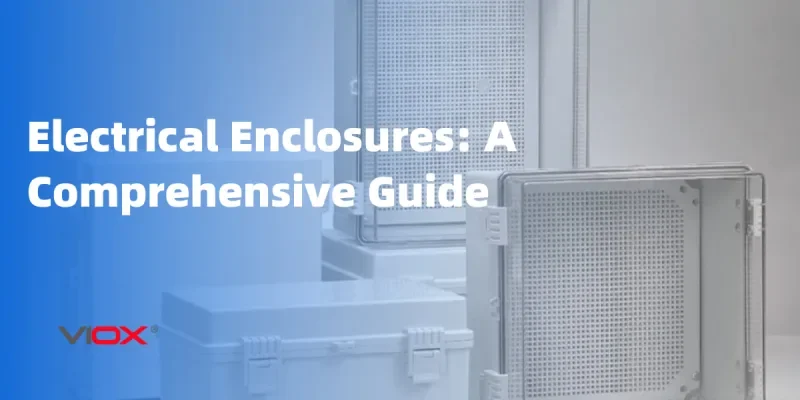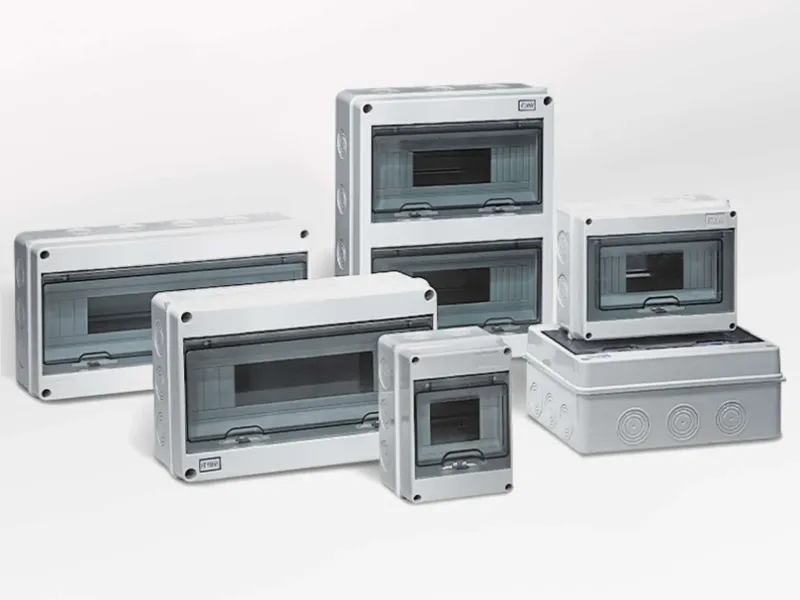An electrical enclosure is a protective housing that shields electrical components from environmental hazards, unauthorized access, and physical damage while ensuring code compliance and operational safety. Choosing the right enclosure prevents equipment failure, reduces fire risks, and meets NEC (国家電気工事規程) requirements that govern electrical installations across residential, commercial, and industrial applications.
What Is an Electrical Enclosure?
An electrical enclosure is a manufactured box or cabinet designed to contain and protect electrical equipment such as サーキットブレーカー, switches, transformers, and control panels. These protective housings serve three critical functions: environmental protection, safety compliance, and operational accessibility.
Key Components of Electrical Enclosures:
- ハウジング素材: Steel, stainless steel, aluminum, fiberglass, or plastic construction
- Sealing System: Gaskets, weatherstripping, or welded seams for environmental protection
- Access Features: Hinged doors, removable covers, or latching mechanisms
- 取り付けオプション: Wall-mount, floor-stand, or pole-mount configurations
- 内部コンポーネント: DIN rails, grounding bars, and component mounting systems
Types of Electrical Enclosures: Complete Comparison
NEMA Rating Classifications
| NEMA Rating | 保護レベル | 代表的な用途 | Indoor/Outdoor | 主な特徴 |
|---|---|---|---|---|
| NEMA 1 | General purpose | Indoor dry locations | 屋内 | Basic protection from accidental contact |
| NEMA 3R | 耐候性 | 屋外設置 | 屋外 | Rain, sleet, snow protection with drain holes |
| NEMA 4 | Watertight | Washdown areas, coastal | Both | Complete water protection, gasket seals |
| ネマ4X | Corrosion resistant | Chemical plants, marine | Both | Stainless steel/fiberglass, chemical resistance |
| NEMA 12 | 産業 | Manufacturing floors | 屋内 | Dust, oil, coolant protection |
| NEMA 6P | Submersible | Below-grade installations | Both | Temporary submersion protection |
Material Comparison Chart
| 素材 | コスト | 耐久性 | 耐食性 | 重量 | 最適なアプリケーション |
|---|---|---|---|---|---|
| Carbon Steel | 低 | 高 | Poor (requires coating) | 重い | Indoor, dry environments |
| ステンレス鋼 | 高 | 非常に高い | 素晴らしい | 重い | Chemical, marine, food processing |
| アルミニウム | 中 | 高 | グッド | ライト | Outdoor, weight-sensitive applications |
| Fiberglass | Medium-High | 高 | 素晴らしい | ライト | Corrosive environments, coastal |
| ポリカーボネート | Low-Medium | 中 | グッド | Very Light | Non-metallic requirements, RF transparency |
Understanding NEMA Ratings vs IP Ratings
NEMA(全米電機工業会) 評価 are North American standards that specify enclosure protection levels, while IP(侵入保護)等級 are international standards used globally.
NEMA to IP Conversion Reference
| NEMA Rating | Equivalent IP Rating | Protection Description |
|---|---|---|
| NEMA 1 | IP10 | Protection from >50mm objects |
| NEMA 3R | IP24 | Protection from rain and >12mm objects |
| NEMA 4 | IP65 | Dust-tight and water jet protection |
| ネマ4X | IP65 | Dust-tight, water jet, corrosion resistant |
| NEMA 12 | IP54 | Limited dust and water splash protection |
| NEMA 6P | IP67 | Dust-tight and temporary submersion |
🔍 Expert Tip: NEMA ratings include additional performance criteria beyond IP ratings, such as corrosion resistance, construction requirements, and testing standards specific to North American conditions.
主なアプリケーションとユースケース
住宅用アプリケーション
- 主に電気パネル: NEMA 1 or 3R depending on location
- Meter bases: NEMA 3R for outdoor installation
- Pool equipment: NEMA 4X for chlorine resistance
- 屋外コンセント: NEMA 3R weatherproof boxes
商業用途
- HVAC controls: NEMA 1 for indoor, NEMA 4 for rooftop units
- Lighting controls: NEMA 1 for office buildings
- セキュリティシステム: NEMA 4 for outdoor cameras and access controls
- Fire alarm panels: NEMA 1 with specific UL certifications
産業用途
- モーター・コントロール・センター: NEMA 12 for manufacturing environments
- Process control: NEMA 4X for chemical processing
- Instrumentation: NEMA 4 for measurement and monitoring
- 配電: NEMA 3R for outdoor substations
How to Select the Right Electrical Enclosure
Step 1: Assess Environmental Conditions
- 所在地: Indoor vs. outdoor installation requirements
- 湿気への露出: Rain, washdown, humidity levels
- 温度範囲: Operating and storage temperature limits
- 化学物質への暴露: Presence of corrosive substances
- Physical hazards: Impact, vibration, or security concerns
Step 2: Determine Size Requirements
- Component inventory: List all equipment to be housed
- Heat dissipation: Calculate thermal load and ventilation needs
- Access requirements: Service clearances and working space
- 将来の拡張: Allow 25% additional space for modifications
- コードコンプライアンス: Meet NEC Article 110.26 working space requirements
Step 3: Material Selection Criteria
Choose Stainless Steel When:
- Chemical exposure is present
- Marine or coastal environments
- Food processing applications
- Long-term corrosion resistance is critical
Choose Aluminum When:
- Weight reduction is important
- Good corrosion resistance is needed
- Cost-effectiveness is a priority
- Outdoor applications without extreme chemicals
Choose Carbon Steel When:
- Indoor, controlled environments
- Budget constraints exist
- High mechanical strength is required
- Proper coating can be maintained
Step 4: Verify Code Compliance
- NEC Article 312: Cabinets, cutout boxes, and meter socket enclosures
- NEC Article 314: Outlet, device, pull, and junction boxes
- 地方改正: Check municipal electrical codes
- UL listings: Ensure appropriate certification for application
⚠️安全警告: Always consult local electrical codes and authorities having jurisdiction (AHJ) before finalizing enclosure selection. Non-compliant installations may result in safety hazards and inspection failures.
インストールのベストプラクティス
設置前の計画
- Site survey: Verify mounting surface and accessibility
- Conduit routing: Plan entry points and cable management
- 接地要件: Ensure proper bonding provisions
- Clearance verification: Confirm working space per NEC 110.26
設置プロセス
- Mounting preparation: Level and secure mounting surface
- Enclosure positioning: Use appropriate fasteners for substrate
- Conduit connections: Install proper fittings and seals
- Grounding installation: Connect equipment grounding conductor
- Component installation: Mount equipment with proper spacing
- 最終テスト: Verify connections and protective systems
避けるべき一般的な設置ミス
- Inadequate sealing: Compromises NEMA rating protection
- 不適切な接地: Creates safety hazards and code violations
- Overpacking: Reduces heat dissipation and accessibility
- Wrong conduit fittings: Allows moisture and contaminant entry
- Insufficient clearances: Violates NEC working space requirements
Troubleshooting Common Enclosure Problems
Moisture Intrusion Issues
症状: Condensation, corrosion, equipment failure
液:
- Verify gasket condition and proper compression
- Check drain holes for blockage (NEMA 3R enclosures)
- Install heaters or ventilation for temperature control
- Upgrade to higher NEMA rating if necessary
過熱の問題
症状: Equipment failures, shortened component life
液:
- Add ventilation fans or louvers
- Increase enclosure size for better heat dissipation
- Install heat exchangers for extreme conditions
- Relocate heat-generating components
Corrosion Concerns
症状: Surface rust, material degradation
液:
- Upgrade to stainless steel or aluminum
- Apply protective coatings to carbon steel
- Improve ventilation to reduce humidity
- Consider cathodic protection for buried applications
Selection Decision Matrix
クイック選択ガイド
| アプリケーションの種類 | 環境 | Recommended NEMA | Material Choice | 特別な考慮事項 |
|---|---|---|---|---|
| Residential Panel | 屋内 | NEMA 1 | Carbon Steel | UL Listed, proper sizing |
| Outdoor Disconnect | Exterior Wall | NEMA 3R | Aluminum/Steel | UV resistant finish |
| プール設備 | Wet Location | ネマ4X | ステンレス鋼 | Chlorine resistance |
| Industrial Control | Factory Floor | NEMA 12 | Carbon Steel | Oil/coolant protection |
| Chemical Process | Corrosive Area | ネマ4X | Stainless/Fiberglass | 化学的適合性 |
| Submersible Pump | Below Grade | NEMA 6P | ステンレス鋼 | Temporary submersion rating |
🔧プロの推奨: When in doubt between two NEMA ratings, choose the higher protection level. The additional cost is typically minimal compared to potential equipment replacement and downtime costs.
Code Compliance and Certification
国立電気コード(NEC)の要件
- 第110.3条(B): Equipment must be listed and labeled
- Article 312: Specific requirements for cabinets and cutout boxes
- Article 314: Junction box and conduit body regulations
- Article 110.26: Working space around electrical equipment
Required Certifications
- UL規格: Underwriters Laboratories safety certification
- CSA Certification: Canadian Standards Association (if applicable)
- NRTL: Nationally Recognized Testing Laboratory approval
- Local approvals: Municipality-specific requirements
Inspection Considerations
- Verify enclosure rating matches application requirements
- Confirm proper installation and grounding
- Check working space clearances
- Validate component arrangement and labeling
Advanced Features and Options
Climate Control Systems
- Heaters: Prevent condensation in cold environments
- Fans: Provide air circulation for heat dissipation
- Air conditioning: Precision cooling for sensitive electronics
- Dehumidifiers: Control moisture in humid conditions
Security Enhancements
- Locking mechanisms: Key locks, combination locks, electronic access
- Tamper-evident seals: Detect unauthorized access
- Viewing windows: Allow status monitoring without opening
- Alarm systems: Remote monitoring of door position
Accessibility Features
- Removable panels: Easy component access
- Hinged doors: Multiple opening options
- Tool-free latches: Quick access for maintenance
- Lift-out components: Simplified service procedures
よくある質問
What’s the difference between weatherproof and watertight enclosures?
Weatherproof enclosures (NEMA 3R) protect against rain, sleet, and snow but allow controlled drainage through weep holes. Watertight enclosures (NEMA 4) provide complete protection against water entry through gasket seals and are suitable for direct water exposure like washdown applications.
Can I modify an existing enclosure to achieve a higher NEMA rating?
Generally no. NEMA ratings are established through comprehensive testing of the complete enclosure system. Field modifications typically void the rating and UL listing. It’s more cost-effective to replace with an appropriately rated enclosure.
How do I calculate the required enclosure size?
Calculate based on component dimensions plus 25% expansion space, minimum wire bending radii per NEC 312.6, and working space requirements. Include thermal considerations for heat-generating equipment and ensure adequate ventilation.
What grounding requirements apply to electrical enclosures?
Per NEC 250.86, metal enclosures must be connected to the equipment grounding conductor. Non-metallic enclosures require grounding only if they contain metallic components that could become energized.
How often should enclosure seals be inspected?
年次点検 is recommended for critical applications. Check gasket condition, compression, and any signs of moisture intrusion. Replace gaskets if cracked, compressed, or showing signs of deterioration.
Can different NEMA-rated components be mixed in one enclosure?
The overall enclosure protection level is limited by the lowest-rated component. All penetrations, fittings, and accessories must maintain the enclosure’s NEMA rating to preserve protection integrity.
What’s the typical lifespan of an electrical enclosure?
Carbon steel enclosures: 15-25 years with proper maintenance
Aluminum enclosures: 20-30 years in appropriate environments
Stainless steel enclosures: 25-40 years with minimal maintenance
Fiberglass enclosures: 20-35 years depending on UV exposure
Are there size limitations for different NEMA ratings?
While NEMA standards don’t specify size limits, larger enclosures face greater challenges maintaining ratings due to thermal expansion, gasket compression, and structural requirements. Custom enclosures may require special engineering and testing.
専門家による設置推奨事項
専門家を雇うべきタイミング:
- Installations requiring electrical permits
- High-voltage applications (over 600V)
- 危険場所への設置
- Complex grounding or bonding requirements
- Custom enclosure modifications
DIY-Appropriate Applications:
- Simple replacement of existing enclosures
- Low-voltage control installations
- Basic residential panel upgrades
- Routine maintenance and inspections
🏆 Expert Insight: Electrical enclosure selection and installation directly impacts system reliability, safety, and code compliance. Investing in proper enclosure specification prevents costly equipment failures and ensures long-term operational success.





